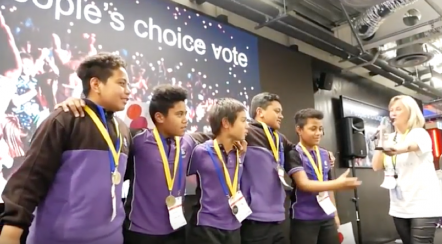iNVENTIONATOR17: An industry incubator event for students

Industry and professional development specialists worked with Linwood Community of Learning | Kāhui Ako to foster student innovation using digital technologies.
The project culminated in a two-day accelerated learning experience – iNVENTIONATOR17:
- teams of years 7–8 students from Linwood Kāhui Ako collaborated to explore and develop their innovative ideas
- the teams pitched to their school communities and a judging panel.
Outcomes and reflections
The event
For iNVENTIONATOR17, CORE Education Tātai Aho Rau partnered with AMY,* Vodafone Xone, and the Ministry of Awesome to provide:
- a high-tech industry venue
- access to inspirational speakers
- exposure to start-up environments, such as Xone
- exposure to possible future pathways
- the inclusion of Xone incubator mentors.
*AMY – AI-based private tutor for math
Student innovations
The student innovations included:
- shoes with LED lights that synced with music to help dancers stay in time during performances
- a pillow called The Chillax that incorporated a range of sleep-inducing gadgets
- a product called Anibots to replace animals exploited in product testing
- a wristband that sends an alert to the teacher via a mobile app when a student needs to ask a question
- a kinetic energy and solar powered solution that charges devices while they are being used.
The winning team was Keyboard Warriors. They designed the recharging solution and were invited to present at the Ministry of Education Cross-Sector Forum: Tech Spaces. This gave students another opportunity to see themselves within the technology industry and to further explore digital technologies.
The teams' learning artifacts were returned to schools so the students could pursue their ideas and solutions.
Reflections
The Story Hui method was used to collect post-event reflections. All of the students spoke positively about their learning experiences.
Tech Future facilitator observations, Story Hui data, and teacher surveys from the incubator and accelerated learning experiences showed that students and teachers displayed three creative capabilities of innovation (Hill, Brandeau, Truelove, and Lineback, 2015).
- Creative abrasion: Collaborative problem solving
- Creative agility: Trying things and learning by discovery and demonstration
- Creative resolution: Creating new and better solutions by integrating existing ideas in unanticipated ways.
Approach
A four-stage process
There were four stages to the project, focused on innovation and collaboration using digital technologies:
- Recruitment and teacher induction
- Learning focused on innovation in schools and kura
- Industry incubator event – iNVENTIONATOR17
- Continuing the teaching and learning focus on innovation and collaboration.
Workshops for teachers
The teacher induction workshops modelled an innovative learning experience and provided resources to scaffold and foster student innovation and technology pedagogies.
The workshops covered the following.
- Curriculum: Making links to the technology curriculum and fostering learning focused on student-centred challenges and solutions.
- Teaching practice: Using strategies and scaffolding learning to explore possibilities, prototype, refine ideas, and provide and receive feedback on technological outcomes.
- Fostering student innovation: Using digital technologies and working collaboratively (online and face-to-face) to deepen learning and create knowledge.
- Collaborative culture: Developing innovation processes to build a culture of collaboration and innovation within the school.
School-based learning: Tools, mentoring, and an innovative community online
A range of tools were prototyped and refined to support learners to define and develop a conceptual design solution for a problem that mattered in their lives. The purpose of these tools was to improve efficiency in start ups and determine what is likely to work and why. The tools align closely to the conceptual framework of the technological practice strand of the technology learning area.
A mentoring kete was used both with the teachers at the induction workshops and by the teachers with their students. The tools encouraged questioning to probe, challenge, encourage ideation, and support students to “get unstuck”.
The Ministry of Awesome ran pitch workshops for the students and provided them with tools for their pitches. The judging criteria was written in “kidspeak “ and made accessible to all.
An innovative community online (ICO) was piloted, using the digital tool, Seesaw. A variety of material was shared through the ICO, including student pitch example videos, technology curriculum documents, and resources such as the tools for conceptual design solutions and teacher guides.
The school-based learning resulted in eleven teams being selected to attend iNVENTIONATOR17 at the Vodafone premises in Christchurch.
Note that the programmes and/or resources used within this project are not officially endorsed by the Ministry of Education.
